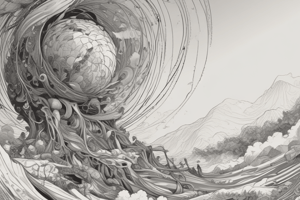Podcast
Questions and Answers
Which principle of art is focused on the focal point or center of interest in an artwork?
Which principle of art is focused on the focal point or center of interest in an artwork?
- Harmony
- Emphasis (correct)
- Balance
- Radial balance
What type of balance is achieved when one side of the composition does not reflect the design of the other but is visually balanced?
What type of balance is achieved when one side of the composition does not reflect the design of the other but is visually balanced?
- Asymmetrical balance (correct)
- Radial balance
- Formal balance
- Symmetrical balance
Which principle of art involves the arrangement of elements and objects around a central point, similar to the spokes on a bicycle wheel?
Which principle of art involves the arrangement of elements and objects around a central point, similar to the spokes on a bicycle wheel?
- Emphasis
- Radial balance (correct)
- Balance
- Harmony
Which principle of art is concerned with the visual weight of elements in a composition?
Which principle of art is concerned with the visual weight of elements in a composition?
Which principle of art involves the use of similar elements and the establishment of pleasing relationships between them?
Which principle of art involves the use of similar elements and the establishment of pleasing relationships between them?
Which type of balance is considered the most stable or formal?
Which type of balance is considered the most stable or formal?
Which principle of art is described as the repetition or continuous flow of regular visual units?
Which principle of art is described as the repetition or continuous flow of regular visual units?
Which artwork is used as an example to illustrate the principle of unity?
Which artwork is used as an example to illustrate the principle of unity?
What principle of art is defined as the comparative relationship of one part to another with regards to size?
What principle of art is defined as the comparative relationship of one part to another with regards to size?
Which artwork exemplifies the principle of contrast?
Which artwork exemplifies the principle of contrast?
What principle of art is described as adding excitement by showing action and directing the viewer's eye?
What principle of art is described as adding excitement by showing action and directing the viewer's eye?
Flashcards are hidden until you start studying
Study Notes
Principles of Art
- The principles of design organize the elements of art in a composition to create a good and beautiful design.
Emphasis
- Emphasis is the focal point or center of interest in an artwork that catches our attention.
- The rest of the elements are subordinates to the emphasis.
Balance
- Balance is achieved by deliberately using elements like value, color, and texture to create visual weight.
- Visual weight is the sense of importance or heaviness created by visual elements.
Types of Balance
- Symmetrical Balance: The most stable kind of balance, also known as formal balance.
- Asymmetrical Balance: Achieved when one side of the composition does not reflect the design of the other but is visually balanced.
- Radial Balance: Elements and objects have a central point, with a circular distribution of elements and objects in a composition.
Harmony
- Harmony means that all parts of a visual image are related and complement each other.
- It is achieved by using similar elements and establishing a pleasing relationship with other elements through a body of work.
Variety
- Variety creates interest and appeal in a body of work.
- It is achieved by placing different visual elements next to one another, such as straight lines next to curvy lines, or organic shapes among geometric shapes.
Movement
- Movement adds excitement to a work by showing action and directing the viewer's eye throughout the picture plane.
Rhythm
- Rhythm in visual arts means repetition or continuation of regular visual units.
- It is created by repeating art elements and creating patterns.
Proportion or Scale
- Proportion or scale refers to the comparative relationship of one part to another with regards to size.
Unity
- Unity is achieved by using all elements and some principles to create a pleasing image.
- It is the result of using all the principles of art to create a cohesive work.
Contrast
- Contrast provides interest and excitement in an artwork or visual experience.
- It is achieved by using different visual elements to create a sense of opposition or difference.
Studying That Suits You
Use AI to generate personalized quizzes and flashcards to suit your learning preferences.




